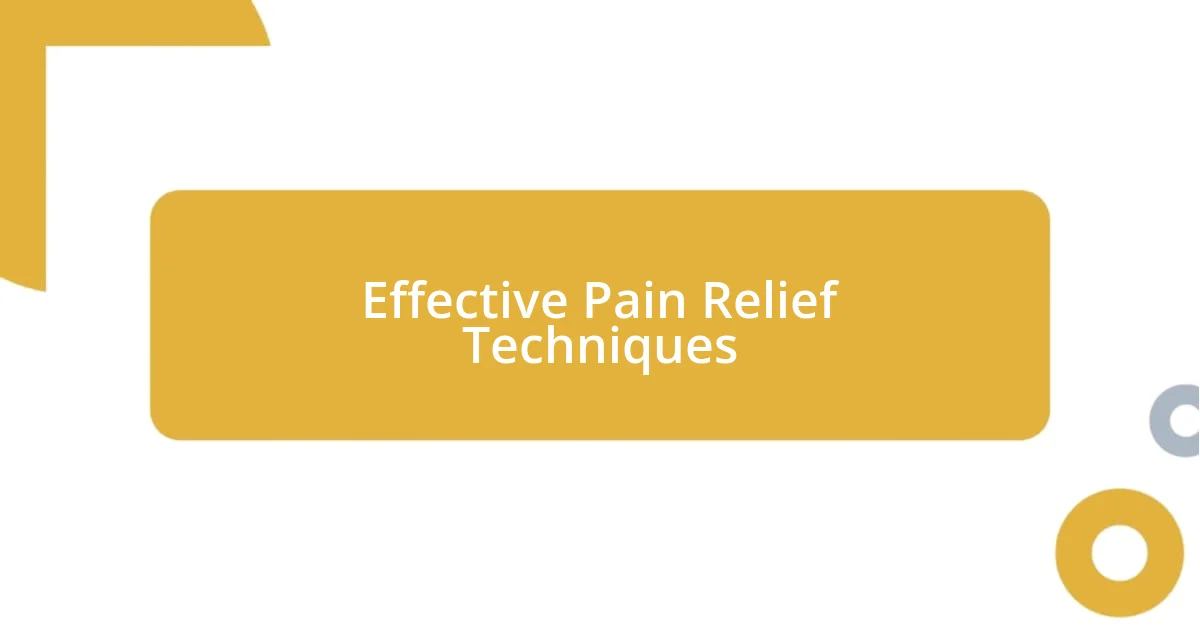Key takeaways:
- Chronic pain management requires addressing physical, mental, and emotional health, emphasizing the importance of a positive mindset and identifying personal pain triggers.
- Incorporating techniques like mindfulness meditation, physical activity, and dietary changes can significantly improve pain perception and overall well-being.
- A supportive environment, built through decluttering, connection with loved ones, and self-care reminders, plays a crucial role in effectively managing chronic pain.

Understanding Chronic Pain Management
Chronic pain management often feels like navigating an endless maze. I remember many nights lying awake, grappling with the pain that seemed to swallow my thoughts. It made me wonder—how could something so invisible affect my life so profoundly? This emotional weight is something many who live with chronic pain can relate to.
Understanding the multifaceted nature of chronic pain is crucial. It’s not merely a physical sensation; it often intertwines with our mental and emotional health. During my journey, I realized that addressing anxiety and depression alongside my pain made a tremendous difference. Have you ever considered how much your mood might influence your pain perception? I discovered that a positive mindset didn’t make the pain vanish, but it certainly softened its grip.
The management of chronic pain isn’t just about quick fixes. Finding what works might require a blend of therapies, from mindfulness techniques to physical treatments. I tried various approaches, but I found that regular physical activity, even in small doses, significantly helped me regain control. What small step can you take today that might pave the way for better pain management tomorrow?

Identifying Personal Pain Triggers
Identifying personal pain triggers is vital in managing chronic pain effectively. I found that keeping a pain journal helped me pinpoint specific activities, emotions, or even foods that preceded my flare-ups. Over time, a clearer picture emerged, illustrating how stress from work often led to increased discomfort. This realization was like lifting a fog; understanding my triggers empowered me to make better choices.
Here are some common triggers that I identified in my own journey:
– Stress: Times of heightened anxiety would often correlate with my worst pain days.
– Certain Activities: Long periods of sitting or standing without movement consistently led to discomfort.
– Sleep Disruption: Poor sleep quality seemed to create a cycle of increased pain and reduced ability to cope.
– Dietary Choices: I noticed a pattern with inflammatory foods exacerbating my symptoms, prompting dietary adjustments.
– Weather Changes: I began to feel as though my body could sense shifts in the weather, especially cold fronts.
Recognizing these triggers has been transformative, guiding my daily decisions and helping me reclaim some sense of control amidst the chaos of chronic pain.

Effective Pain Relief Techniques
Managing pain effectively often requires a diverse toolkit of techniques tailored to individual experiences. Over the years, I discovered that combining mindfulness meditation with physical therapy yielded remarkable results. When I dedicated just ten minutes a day to mindfulness, I noticed a significant shift in my ability to cope with discomfort. Have you ever tested a simple technique and been surprised by its effectiveness? Sometimes, small adjustments can have a profound impact.
Another technique that worked for me was the use of heat therapy. I vividly remember one particularly cold evening when I felt my body tense up in pain. Wrapping myself in a warm blanket and using a heating pad transformed my experience. Heat helps to relax tight muscles and improve blood flow, making it a soothing remedy when discomfort strikes. Simple yet effective methods often become our most trusted allies in this journey.
It’s also important to consider the role of nutrition in pain management. I had an eye-opening moment when I replaced processed snacks with fruits and vegetables. Not only did my energy levels increase, but I also noticed a decrease in inflammation over time. Eating for pain relief isn’t just a trend; it’s a lifestyle change that can lead to long-term benefits. What dietary changes might you explore to support your wellness journey?
| Technique | Description |
|---|---|
| Mindfulness Meditation | Practicing mindfulness helps manage pain perception and connects mind and body. |
| Heat Therapy | Using heat helps relax tight muscles and alleviates discomfort. |
| Nutrition | A diet rich in anti-inflammatory foods can reduce pain and improve overall health. |

Integrating Mindfulness and Meditation
I can’t tell you how powerful integrating mindfulness and meditation has been in my pain management journey. There were days when pain seemed all-consuming, but taking just a few moments to focus on my breath made a noticeable difference. I remember sitting quietly, closing my eyes, and letting my thoughts drift. This practice not only calmed my mind but also softened the physical tension I was experiencing. Have you ever noticed how simply slowing down can shift your perspective on discomfort?
There was one particular instance when I was feeling overwhelmed by a flare-up. I decided to try a guided meditation that focused on body awareness. As I visualized the pain radiating through my body, instead of tensing up against it, I embraced it with a sense of curiosity. This approach transformed my experience; rather than resisting the pain, I began to develop a kind of acceptance. I found that meditation offered a space where I could observe my sensations without judgment, which was incredibly liberating.
Incorporating mindfulness throughout my daily routine has allowed me to create a calming rhythm in my life. I often pause during moments of stress—whether it’s during a busy workday or at home—and take a minute to refocus. It’s remarkable how this small shift influences my pain perception. I’ve come to realize that mindfulness is not just a technique; it’s a way of life. How might weaving mindfulness into your daily tasks change your relationship with pain?

The Role of Physical Activity
When I began incorporating regular physical activity into my routine, I was genuinely taken aback by the effects it had on my pain levels. Initially, I was hesitant—who wants to work out when they’re in pain? But the first time I went for a gentle walk, I was filled with a sense of freedom I hadn’t felt in a long time. I remember feeling the sun’s warmth on my skin and, surprisingly, my discomfort didn’t seem as intense. Have you ever felt relief unexpectedly while doing something as simple as walking?
Over time, I learned that movement doesn’t always mean rigorously hitting the gym. I found that dancing in my living room or doing yoga could lift my spirits and distract me from persistent aches. One evening, after a long day, I turned on my favorite playlist and danced like nobody was watching. It was a joyful experience that made my body feel lighter and, dare I say, more vibrant. It’s incredible how a little movement can change our mood and perception of pain—maybe it’s the endorphins kicking in or just feeling more connected to my body.
As I became more consistent with physical activity, I noticed a shift in my overall mindset. Instead of viewing my body solely as a vessel of pain, I began to appreciate its strength and resilience. One rainy afternoon, after a particularly energizing workout, I took a moment to reflect on the progress I had made. It dawned on me that my body was capable of far more than I had been giving it credit for. Isn’t it fascinating how moving our bodies can lead to shifts in both physical and emotional well-being?

Exploring Alternative Therapies
Exploring alternative therapies has truly opened my eyes to new possibilities in managing pain. I vividly recall a time when I decided to try acupuncture. As the needles were gently placed, I felt a mix of excitement and skepticism. Within moments, I noticed a warmth spreading through my body. That simple experience left me amazed; it felt like my tension was melting away. Have you ever felt a sudden shift just from a different approach?
Another method that caught my attention was aromatherapy. During one particularly frustrating day, I lit a lavender-scented candle, hoping for a hint of calm. The scent enveloped me, and I found myself taking deeper breaths. Almost instinctively, I could feel my heart rate slow down. It’s intriguing how something as simple as aroma can influence our mood and even how we perceive pain. What scents resonate with you personally, and how might they transform your pain experience?
I also explored the world of herbal supplements, and one in particular, turmeric, stood out for its anti-inflammatory properties. I remember experimenting with turmeric tea on a chilly evening. The warmth of the drink coupled with the soothing flavors created a comforting ritual. This approach not only tapped into my cultural roots but also provided an unexpected sense of control over my pain management. What if embracing nature’s offerings could change the way we navigate discomfort? Exploring these alternatives has not only enriched my toolkit but also deepened my understanding of my body’s needs.

Creating a Supportive Environment
Creating a supportive environment around me has proven crucial in managing my pain effectively. I remember a pivotal moment when I decided to transform my living space—reducing clutter and adding soft lighting. Walking into that calmer atmosphere, I instantly felt a weight lifted off my shoulders. It’s amazing how our surroundings can impact our mental well-being. Have you ever noticed how a tidy space can make you feel more in control?
Another element I found helpful is the power of connection with loved ones. During difficult days, simply having a friend over for a chat or a family member nearby can work wonders. I recall sitting on my couch with my sister, laughing and sharing stories. Even though I wasn’t in perfect health, those moments of laughter made my pain seem distant. What role do your relationships play in how you tackle your discomfort?
Lastly, I cannot overlook the significance of gentle reminders to practice self-care. I’ve placed sticky notes with affirmations around my home—messages like “It’s okay to rest” and “You are more than your pain.” On a particularly tough morning when the pain felt overwhelming, I stumbled upon one of those notes. It was a gentle nudge to prioritize my well-being and take it slow. How often do we forget to give ourselves permission to care for our own needs? Creating an environment that fosters tenderness and self-compassion has been a game-changer in my journey.












